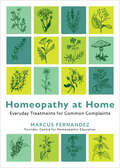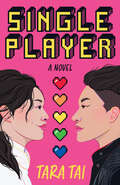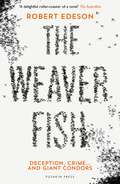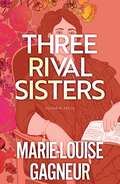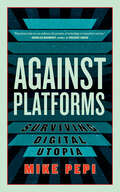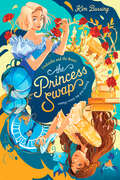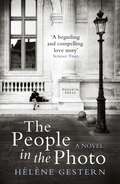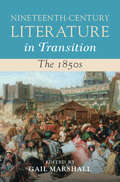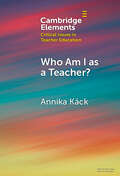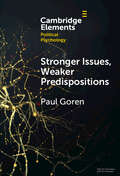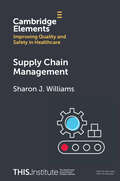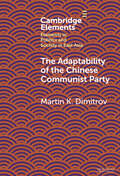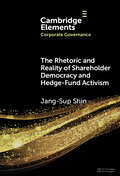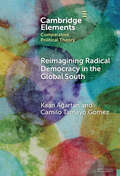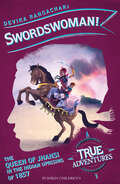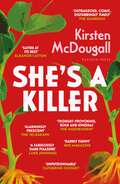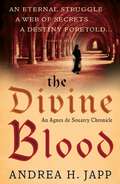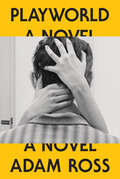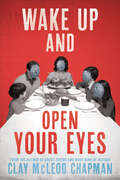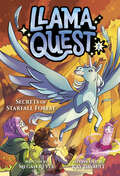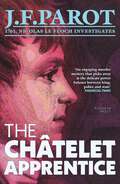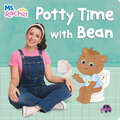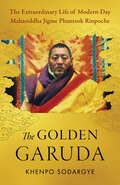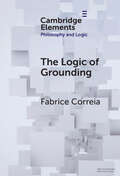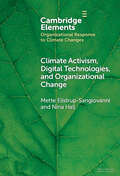- Table View
- List View
Homeopathy at Home: Everyday Treatments for Common Complaints
by Marcus FernandezYour health is in your hands with this easy guide to homeopathy, offering expert, actionable wisdom to help you take control of your wellbeing.Discover how to treat everyday acute issues confidently and safely using homeopathic remedies at home. By matching the characteristic symptoms of common complaints with the correct homeopathic treatment, you can unlock your body&’s incredible natural ability to heal.This guide offers a comprehensive A–Z of homeopathic remedies for a wide range of complaints – from common colds, coughs, allergies and infections, to cuts, bruises, acne and PMS. It also provides useful substitutions that can easily be found in your kitchen or garden – so you&’ll always have a natural remedy to hand.With this book, you&’ll have everything you need to address everyday health issues naturally and effectively.
Single Player: A Novel
by Tara TaiTwo video game creators go head-to-head in this delightful, queer enemies-to-lovers workplace romance debut, perfect for fans of TJ Alexander and Helen Hoang.Cat Li cares about two things: video games and swoony romances. The former means there hasn't been much of the latter in her (real) life, but when she lands her dream job writing the love storylines for Compass Hollow—the next big thing in games—she knows it&’s all been worth it. Then she meets her boss: the infamous Andi Zhang, who&’s not only an arrogant hater of happily-ever-afters determined to keep Cat from doing her job but also impossibly, annoyingly hot.As Compass Hollow&’s narrative director, Andi couldn&’t care less about love—in-game or out. After getting doxxed by internet trolls three years ago, Andi&’s been trying to prove to the gaming world that they&’re a serious gamedev. Their plan includes writing the best game possible, with zero lovey-dovey stuff. That is, until the man funding the game&’s development insists Andi add romance in order to make the story &“more appealing to female gamers.&”Forced to give Cat a chance, Andi begrudgingly realizes there&’s more to Cat than romantic idealism and, okay, a cute smile. But admitting that would mean giving up the single-player life that has kept their heart safe for years. And when Cat uncovers a behind-the-scenes plot to destroy Andi&’s career, the two will have to put their differences aside and find a way to work together before it&’s game over.
The Weaver Fish
by Robert EdesonWhen linguist Edvard Tøssentern vanishes into thin air in pursuit of an obsession, his companion Anna Camenes flies to the Ferendes to look for him. There, Edvard's colleagues are increasingly disturbed by nefarious activities taking place around their research station. When a second man goes missing, intelligence analyst Richard Worse joins the investigation. Together, they will face cold-hearted villainy - and mysteries more baffling than the mind can conjure.
Three Rival Sisters
by Marie-Louise GagneurIT IS MOST UNWISE AND FOOLISH TO ENDEAVOUR TO MANIPULATE HUMAN EMOTION FOR ONE'S ENDS'One May morning in 1842 in the village of Domblans, sisters Henriette, Renée and Gabrielle finally have something beyond embroidery to occupy them: the eligible bachelor Monsieur de Vaudrey is to visit their father's chateau. Yet as they compete for his affections, they learn that marriage and happiness do not always go hand in hand.Meanwhile, upon his wife's death, the Comte de Montbarrey finds himself free to marry the woman he loves, but haunted by the possibility that he may have been the Comtesse's killer. How can he atone for an act he does not remember, and for the sins of the idle life to which he was born?Steeped in wit, empathy and social critique, the two stories in this volume show popular late nineteenth-century author Marie-Louise Gagneur to be worthy of renewed attention.
Against Platforms: Surviving Digital Utopia (Activist Citizens Library)
by Mike PepiA bold and imaginative critique of the hidden costs of digital life – and a manifesto for a better future . . .At the turn of the millennium, digital technologies seemed to have immense promise for transforming our society. With these powerful new tools, the thinking went, we would be free to live our best lives, connected to our communities in ways full of infinite potential.A quarter of a century on, this form of utopianism seems like a cruel mirage. Our lives are more fragmented and pressure-filled as ever, as we race to keep up with technologies that manipulate, command, and drain us at every turn. So what happened? In Against Platforms, technologist and creator Mike Pepi lays out an explanation of what went wrong – and a manifesto for putting it right.The key, says Pepi, is that we have been taught that digital technologies are neutral tools, transparent, easily understood, and here to serve us. The reality, Pepi says, is that they are laden with assumptions and collateral consequences – ideology, in other words. And it is this hidden ideology that must be dismantled if we are to harness technology for the fullest expression of our humanity.
Cinderella and the Beast (The Princess Swap)
by Kim BussingWhat would happen if Cinderella found herself in the beast's castle, and Beauty woke up in some evil stepmother's home? Fairy tales meet Freaky Friday in this series, where there&’s a magical mix-up for every princess!*The magical first edition paperback of Cinderella and the Beast (or, Beauty and the Glass Slipper) will feature dual-toned sprayed edges!*Ella&’s spent her life dreaming about adventure, but it&’s hard to have adventures when you&’re stuck with a stepfamily who treat you like a servant. When she unexpectedly wakes up in a land far, far away, she&’s thrilled at the chance to embark on an epic quest. That is, until she finds herself trapped once more—this time in the castle of a dangerous beast.Belle, meanwhile, has plans. Her family&’s trading company is on the brink of ruin, and to save it, she&’s going to enter—and win—a royal competition in the prince&’s honor. But when she unexpectedly winds up in a cellar with a wicked stepfamily who have their own plans to keep her from the competition . . . things get complicated.Happily-ever-after couldn&’t feel farther away. Can Ella escape the beast&’s clutches? And can Belle get rid of this stepfamily in time for the competition?For other Princess Swaps, don't miss Snow White and the Dragon (or, Sleeping Beauty and the Seven Dwarfs)!
The People in the Photo
by Hélène GesternThe photograph has fixed the three figures for ever, two men and a woman bathed in bright sunshine.Parisian archivist Hélène knows very little about her mother, Nathalie, who died when she was three. She decides to place a newspaper advert requesting information on Nathalie and two unknown men pictured with her at a tennis tournament in 1971.Against the odds, she receives a response from Stéphane, a Swiss biologist: his father is one of the people in the photo. Further letters and photos pass between them; but as they try to piece together the past, will they discover more than they can actually deal with?Winner of over thirty literary awards, this dark yet moving drama deftly explores the themes of blame and forgiveness, identity and love.
Nineteenth-Century Literature in Transition: The 1850s (Nineteenth-Century Literature in Transition)
by Gail MarshallEstablishing a fresh critical paradigm, this volume shows how the 1850s was significantly defined by forms of increasing intellectual, class, and geographical mobility. It saw the flourishing of major Victorian writers, including George Eliot, Elizabeth Gaskell, Charles Dickens, W. M. Thackeray, Matthew Arnold, Charles Kingsley, Anthony Trollope, Tennyson, and Elizabeth Barrett and Robert Browning. Outputs by these writers were read alongside a variety of other genres, including travel writings, learned society reports, statistical returns, popular journalism, working-class writing, and scientific papers in a period which saw an increasing availability of cheap printed matter. Intertextuality and interdisciplinarity are not only key to this volume, but are also one of the most important legacies of the literature of the 1850s. Contributors are attentive to a plethora of voices, disciplines, and forms of knowledge which they read through rigorous 21st-century critical priorities including diversity, cultural and physical geography, and the environment.
Who Am I as a Teacher?: Migrant Teachers' Redefined Professional Identity (Elements in Critical Issues in Teacher Education)
by Annika KäckRedefined transformative learning refers to learning that implies a change in the learner's identity, which includes cognitive, emotional, and social dimensions and is something all teachers, in this case migrant teachers, experience and negotiate when meeting a new educational context. “Who am I as a teacher in a new country?” migrant teachers ask themselves. To understand oneself as a teacher, one must identify and coordinate the past and present with a future direction, which causes migrant teachers to talk about a transformed professional identity with additional skills. This Element concerns migrant teachers' transformation, how they redefine their professional identity, and how to support this in teacher education.
Stronger Issues, Weaker Predispositions: Abortion, Gay Rights, and Authoritarianism (Elements in Political Psychology)
by Paul GorenPolitical psychologists have long theorized that authoritarianism structures the positions people take on cultural issues and their party ties. Authoritarianism is durable; it resists the influence of other political judgments; and it is very impactful-in a word, it is strong. By contrast, researchers characterize the attitudes most people hold on most issues as unstable and ineffectual-in a word, weak. But what is true of most issues is not true of the issues that have driven America's long running culture war-abortion and gay rights. This Element demonstrates that moral issue attitudes are stronger than authoritarianism. With data from multiple sources over the period 1992-2020, it shows that (1) moral issue attitudes endure longer than authoritarianism; (2) moral issues predict change in authoritarianism; (3) authoritarianism does not systematically predict change in moral issues; and (4) moral issues have always played a much greater role structuring party ties than authoritarianism.
Supply Chain Management (Elements of Improving Quality and Safety in Healthcare)
by Sharon J. WilliamsCreating a well-integrated, resilient, and highly transparent supply chain is central to effective and safe patient care. But managing healthcare supply chains is complex; common challenges include the underuse, overuse, and misuse of health resources. This Element introduces the key principles and definitions of healthcare supply chains. Practical insights into the design and operation of healthcare supply chains are provided. Core characteristics of effective supply chain management such as performance management, systems thinking, and supply chain integration are examined along with the application of specific supply chain design and improvement approaches. Finally, the Element proposes areas that require further development both in research and practice. This title is also available as open access on Cambridge Core.
The Adaptability of the Chinese Communist Party (Elements in Politics and Society in East Asia)
by Martin K. DimitrovThe Chinese Communist Party (CCP) celebrated its one-hundredth birthday in 2021. Its durability poses a twofold question: How has the party survived thus far? And is its survival formula sustainable in the future? This Element argues that the CCP has displayed a continuous capacity for adaptation, most recently in response to the 1989 Tiananmen protests and the collapse of communism in Europe. As the CCP evaluated the lessons of 1989, it identified four threats to single-party rule: economic stagnation; socioeconomic discontent; ideological subversion; and political pluralism. These threats have led to adaptive responses: allowing more private activity; expansion of the social safety net; promotion of indigenous cultural production; and rival incorporation into the party. Although these responses have enabled the CCP to survive thus far, each is reaching its limit. As adaptation stagnates, the strategy has been to increase repression, which creates doubt about the ongoing viability of single-party rule.
The Rhetoric and Reality of Shareholder Democracy and Hedge-Fund Activism (Elements in Corporate Governance)
by Jan-Sup ShinThis Element investigates the historical and systemic roots of hedge-fund activism. It argues that the spirit of the New Deal financial regulations was subverted in the 1980s and 1990s in the name of shareholder democracy and opened the door for the rise of hedge-fund activism. It analyzes the effects of regulatory reforms including the introduction of compulsory voting by institutional investors, proxy-voting rule changes that greatly facilitated aggregation of the proxy votes of institutional investors, and rules that allow hedge funds to draw effectively limitless alternative investments from institutional investors. This Element also evaluates the recent empirical research on hedge-fund activism and explains why shareholder activism has gone awry. It argues that the regulatory changes created a large vacuum in the arena of corporate voting that hedge-fund activists can effectively exploit for their own profits. It concludes with policy proposals for rebuilding the proxy-voting and engagement system.
Reimagining Radical Democracy in the Global South: Emerging Paradigms from Colombia and Türkiye (Elements in Comparative Political Theory)
by Kaan Ağartan Camilo Tamayo GomezRadical democracy informs contemporary social movements both as critique of existing liberal democratic social orders and as inspiration for collective action to challenge power structures. However, existing approaches on the relationship between radical democracy and social movements often truncate complex socio-political issues, constraining political imagination and stifling 'truly radical' alternatives. This Element offers an analysis of contemporary social movements in Colombia and Turkey to show the limits and potential of radical democracy to reimagine new expressions of citizenship and non-capitalist alternatives. It argues that there is a mismatch between the radical democratic paradigm as it is formulated within Eurocentric purview, and the ways it has been articulated and practised by anti-austerity and pro-democracy movements of the twenty-first century. We propose that radical democracy should be rethought in light of novel forms of political activism and visions emerging from these social movements as a response to the failures of liberal democracy.
Swordswoman!: The Queen of Jhansi in the Indian Uprising of 1857 (True Adventures)
by DEVIKA RANGACHARIThe true story of the fearsome Rani of Jhansi, the Indian Queen who took on the East India Trading Company in the Indian Uprising of 1857Queen Lakshmibai of Jhansi was an unconventional queen. She could read and write; she rode a horse and wielded a sword; she trained other women to ride and fight alongside her. When the East India Trading Company, who ruled India in the 19th century, demanded that she hand over control of Jhansi, she refused.And when an uprising began to stir in 1857, and the British laid siege to her fortress, the warrior queen tied her infant son to her back, mounted her favourite horse, and escaped to raise an army.This is the story of a woman who defied all conventions to become an icon of resistance in colonial-era India.
She's A Killer
by Kirsten McdougallAlice is struggling to find things to care about. Branded 'smarter than most' at the age of seven, she now works in Enrolments at the local university and spends her time stalking the internet for shoes she can't afford. Meanwhile, the climate is in crisis and wealthy immigrants are flocking to New Zealand for shelter, stealing land, driving up food prices and taking over.When Alice meets teenage genius Erika, life suddenly gets a lot more interesting. But Erika soon reveals a dangerous plan to set things 'right', forcing Alice out of indifference and into action of the most radical kind. Just what is a slacker to do?
The Divine Blood and the Combat of Shadows: The Lady Agnès Mystery, Volume 2
by Andrea JappAgnès de Souarcy has survived the medieval Inquisition, but remains the focus of an ancient quest.Her protectors must battle with the powerful enemies of the quest who will stop at nothing to see it fail. 'Five women, in the centre the sixth' are the enigmatic words foretelling Agnes's destiny. But will she fulfil the role that has been prophesied?Japp offers the reader a fast-paced, multi-layered mystery within a richly imagined portrait of medieval France.
Playworld: A Novel
by Adam Ross"Starting off 2025 with a novel this terrific gives me hope for the whole year." —Ron Charles, The Washington Post"A gorgeous cat's cradle of a book . . . The swirling vapors of Holden Caulfield are present in Playworld, for sure, but also Lolita, Willy Loman, Garp." —Alexandra Jacobs, The New York Times Book Review"Extraordinary . . . A beguiling ode to a lost era . . . Line for line the book is a revelation." —Leigh Haber, Los Angeles TimesA big and big-hearted novel—one enthralling, transformative year in the life of a child actor coming of age in a bygone Manhattan, from the critically acclaimed author of Mr. Peanut&“In the fall of 1980, when I was fourteen, a friend of my parents named Naomi Shah fell in love with me. She was thirty-six, a mother of two, and married to a wealthy man. Like so many things that happened to me that year, it didn&’t seem strange at the time.&” Griffin Hurt is in over his head. Between his role as Peter Proton on the hit TV show The Nuclear Family and the pressure of high school at New York's elite Boyd Prep—along with the increasingly compromising demands of his wrestling coach—he's teetering on the edge of collapse. Then comes Naomi Shah, twenty-two years Griffin&’s senior. Unwilling to lay his burdens on his shrink—whom he shares with his father, mother, and younger brother, Oren—Griffin soon finds himself in the back of Naomi&’s Mercedes sedan, again and again, confessing all to the one person who might do him the most harm. Less a bildungsroman than a story of miseducation, Playworld is a novel of epic proportions, bursting with laughter and heartache. Adam Ross immerses us in the life of Griffin and his loving (yet disintegrating) family while seeming to evoke the entirety of Manhattan and the ethos of an era—with Jimmy Carter on his way out and a B-list celebrity named Ronald Reagan on his way in. Surrounded by adults who embody the age&’s excesses—and who seem to care little about what their children are up to—Griffin is left to himself to find the line between youth and maturity, dependence and love, acting and truly grappling with life.
Wake Up and Open Your Eyes
by Clay Chapman&“Clay McLeod Chapman is one of my favorite horror storytellers working today.&”—Jordan Peele&“Surreal, hypnotic, unrelenting, profoundly claustrophobic, and an absolutely scathing send-up of the pitfalls of American divisiveness.&”—Keith Rosson, author of Fever HouseFrom master of horror Clay McLeod Chapman, a relentless social horror novel about a family on the run from a demonic possession epidemic that spreads through media.Noah has been losing his polite Southern parents to far-right cable news for years, so when his mother leaves him a voicemail warning him that the &“Great Reawakening&” is here, he assumes it&’s related to one of her many conspiracy theories. But when his phone calls go unanswered, Noah makes the drive from Brooklyn to Richmond, Virginia. There, he discovers his childhood home in shambles and his parents locked in a terrifying trancelike state in front of the TV. Panicked, Noah attempts to snap them out of it.Then Noah&’s mother brutally attacks him.But Noah isn&’t the only person to be attacked by a loved one. Families across the country are tearing each other apart—literally—as people succumb to a form of possession that gets worse the more time they spend glued to a screen. In Noah&’s Richmond-based family, only he and his young nephew Marcus are unaffected. Together, they must race back to the safe haven of Brooklyn—but can they make it before they fall prey to the violent hordes?This ambitious, searing novel from one of horror's modern masters holds a mirror to our divided nation, and will shake readers to the core.
Llama Quest #2: Secrets of Starfall Forest (Llama Quest)
by Megan ReyesStart your quest with a talking purple llama and protect the Kingdom of Ravenwood! Join eight-year-old Dak as he's swept into a magical adventure to protect the people and creatures of their kingdom!One day, Dak was scooping llama poop on his family's farm. The next, he's on a magical adventure to save the kingdom! Dak, Fenn, and the magical llama Lucy have found the Fire Stone but eleven of the magical stones that protect Ravenwood are still missing! The search for the next stone leads Dak, Fenn, and Lucy to Starfall Forest, where the very shy and protective herd of alicorns—magical horses with wings and a horn—live. The alicorns have the Star Stone, and it's leaking magic everywhere and causing havoc at the royal wedding! Can Dak, Fenn, and Lucy find a way to gain the alicorns&’ trust and get the Star Stone back? They&’ll encounter magical creatures, a sneaky thief, and tricky magic, but when they work together, nothing can beat Team Llama Quest! Join Team Llama Quest on all their adventures! #1 Danger in the Dragons' Den#2 Secrets of Starfall Forest
The Châtelet Apprentice: A Nicolas Le Floch Investigation, Book 1
by Jean-François ParotFebruary 1761Beyond the glittering court of Louis XV and Madame de Pompadour at Versailles, lies Paris, a capital in the grip of crime and immorality . . .A police officer disappears and Nicolas Le Floch, a young recruit to the force, is instructed to find him. When unidentified human remains suddenly come to light, he seems to have a murder investigation on his hands. As the city descends into Carnival debauchery, Le Floch will need all his skill, courage and integrity to unravel a mystery which threatens to implicate the highest in the land.
Potty Time with Bean (Books by Ms. Rachel)
by Ms. RachelToddlers can now learn to use the potty with Ms. Rachel— YouTube phenomenon, household name, and America&’s favorite teacher!For many young children and their caregivers, potty training is an uncertain time in their lives. Ms. Rachel&’s comforting and age-appropriate Potty Time is fun, educational, and perfect for those embarking on this milestone. With sweet illustrations, familiar songs, and have-to-know gestures, Ms. Rachel brings her expertise in an engaging story that will have little ones using the potty in no time. Features helpful potty training tips and advice in the back to assist with this important developmental milestone!
The Golden Garuda: The Extraordinary Life of Modern-Day Mahasiddha Jigme Phuntsok Rinpoche
by Khenpo SodargyeA moving biography of Jigme Phuntsok Rinpoche, one of the twentieth century&’s most influential Tibetan Buddhist teachers, written by his devoted student Khenpo Sodargye.30 black-and-white historical photographs illustrate this remarkable life story.Jigme Phuntsok Rinpoche (1933–2004) was one of the most influential Buddhist teachers of the twentieth century. In this moving biography, Khenpo Sodargye—a lead teacher at Larung Gar Five Sciences Buddhist Academy—brings his beloved root teacher&’s remarkable story and accomplishments to life with wisdom and reverence. His personal anecdotes coupled with the prophecies of great masters and verse from Buddhist texts offer a portrait that is at once intimate and profound, revealing Jigme Phuntsok&’s legacy as the mythical &“golden garuda&” who was instrumental in the flourishing of Buddhism. During a pivotal period in modern Tibetan history, he created the world&’s largest Buddhist institution, attracted thousands of followers with his nonsectarian teachings, and taught some of today&’s great Tibetan Buddhist teachers. The engaging narrative unfolds chronologically in dozens of short, impactful chapters. We&’re introduced to Jigme Phuntsok&’s previous incarnations and learn about his early years. We experience his teaching trips, including a journey to the holy mountain of Wutaishan in China together with ten thousand Tibetan disciples. We learn about his visionary experiences and revelations, including one that failed—a rare account in Tibetan literature of such an occurrence. With elements of biography, travelogue, and magical tale, this life story contains adventure, suffering, and human connection. This portrayal of the great Jigme Phuntsok Rinpoche&’s compassionate life dedicated to spiritual practice and teaching will inspire Buddhist practitioners and meditators and readers with an interest in modern Tibetan and Buddhist history.
The Logic of Grounding (Elements in Philosophy and Logic)
by Fabrice CorreiaThe concept of grounding – of a fact obtaining in virtue of other facts – has been a topic of intensive philosophical and logical investigation over roughly the past two decades. Many philosophers take grounding to deserve a central place in metaphysical theorizing, in great part because it is thought to do a better job than other concepts – e.g., reduction and supervenience – at capturing certain phenomena. Studies on the logic of grounding have largely been conducted with this philosophical background in mind. In this Element, I try to give a faithful picture of the contemporary development of the logic of grounding in a way that is both reasonably comprehensive and reasonably systematic.
Climate Activism, Digital Technologies, and Organizational Change (Organizational Response to Climate Change: Businesses, Governments)
by Mette Eilstrup-Sangiovanni Nina HallNon-governmental and civil society organizations have long been recognized as crucial players in climate politics. Today, thanks to the internet, social media, satellite, and more, climate activists are pioneering new organizational forms and strategies. Organizations like Fridays for Future, 350.org, and GetUp! have used social media and other digital platforms to mobilize millions of people. Many NGOs use digital tools to collect and analyze 'big data' on environmental factors, and to investigate and prosecute environmental crimes. Although the rise of digitally based advocacy organizations is well documented, we know less about how digital technologies are used in different aspects of climate activism, and with what effects. On this basis, we ask: how do NGOs use digital technology to campaign for climate action? What are the benefits and downsides of using technology to push for political change? To what extent does technology influence the goals activists strive for and their strategies.
